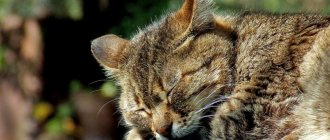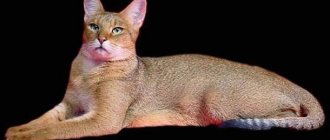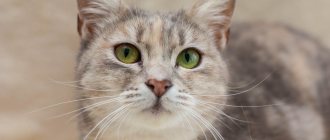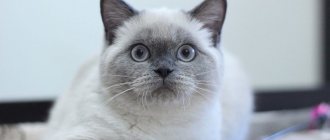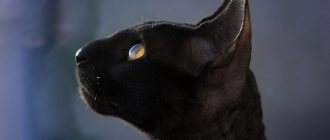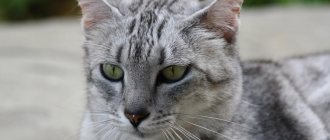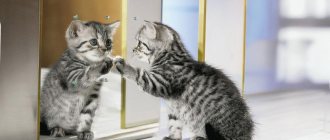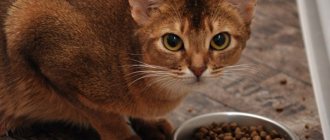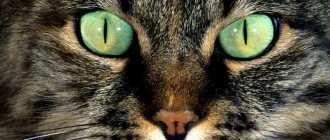One of the reasons why people love cats so much is their magical, mesmerizing eyes, wide open and unusually expressive for an animal. Even among fashionable makeup trends, cat eyes always remain popular, lined with arrows to give the appropriate shape. The beauty of a cat's eyes is largely explained by their size - of all domestic animals, the cat has the largest eyes compared to the size of the body. This is due to the nocturnal lifestyle of cats, and the special structure of their eyes is explained by the same reasons.
What colors do cats see? Do cats see the same as people? What does the world look like for a person’s furry companions, and what are the features of a cat’s vision?
Features of cat eyes
Many people know that cats see perfectly in darkness that is impenetrable to humans. But in fact, people exaggerate the visual abilities of cats; unfortunately, their vision is blurry and unclear, and in the daytime, cats see worse than us. Their eyes are extremely sensitive to bright rays of light, and their vertical pupils help protect them from the sun. During the day they squint their eyes, so they like to sleep at this time.
Cats, like humans, have binocular vision, i.e. With each eye they see a certain picture, which overlaps and is transformed into one whole image. Moreover, these animals have a viewing radius of 200 degrees, while humans have only 180.
Features of vision of four-legged pets
Scientists attribute the vision of representatives of the cat family, like that of humans, to the binocular type. The animal can view objects with both eyes at once. This is inherent in nature for the possibility of hunting or orientation in the area. Thanks to the interesting structure of the eyes, the cat quickly and at a distance determines the location of prey .
- From its ancient ancestors the animal received a stereoscopic visual type. The cat sees the world around it in three dimensions. This helps to accurately determine distances to objects of interest.
- The cat perfectly sees moving objects on a horizontal surface. To view the sides and top, the animal turns its head. However, this does not detract from the ability to accurately determine the distance to jump, although it does change the angle of view.
- A cat sees stationary objects poorly, but moving ones – perfectly. Animals have vertical pupils, the constriction of which is more intense due to the brightness of the light. In twilight or darkness, on the contrary, expansion occurs. Such features of the pupils allow animals to see perfectly at any light intensity, regardless of the time of day.
© shutterstock
The cat has a third eyelid, endowed with a protective function. It saves the eyeball from injury and drying out. Thanks to the third eyelid, a cat can look for a long time without blinking.
Shades of colors that a cat can distinguish
From biology we know that the lens of the eye consists of photoreceptors called rods and cones. Thanks to the former, cats have developed special night vision, and the latter - the ability to perceive color. Due to the fact that they have fewer cones than rods, cats have an advantage in nighttime visual acuity.
A curious fact is that in the eye structure of cats there is a tapetum - a specific formation responsible for the scattering of unabsorbed rays. Light is sent by the tapetum to the retina. A person sees the glowing eyes of an animal, but in reality these are reflected rays of light.
Previously, there was an opinion that only achromatic colors (white, black and shades of gray) were available to cats. However, thanks to scientific research on this topic, scientists have come to the conclusion that since cats have cones in their eyes, it means that they distinguish not only black and white colors, but also a spectrum of colors.
Fluffy pets perceive blue and green tones well, distinguish between purple colors, yellow ones are often confused with white ones, and red, brown and orange colors are not available to them.
The structure of a cat's eyes
The vision of all mammals is the same. The pupil transmits light through the lens onto the retina, forming an inverted image there. The retina transmits a signal through the optic nerves to the part of the brain responsible for visual perception. The brain flips the image and forms the real picture.
But there are still differences in the perception of the world. They are determined by the structure of the eyes and evolution.
Features of cat's eyes and the influence of anatomy on vision.
- Proportions of eyes and body . Compared to humans, cats have huge eyes. If we correlate the proportions of the body and eyes, then people's eyes would be the size of a large orange. Therefore, the lens of a cat’s eyes is larger, and so is the field of view. Human vision spans 180, versus a cat's 200 degrees. But the zone of peripheral vision, in which objects are clearly visible, is larger in humans. Focusing is also determined by the size of the eyes. People see everything in front of them quite sharply. Cats focus only on individual objects, the rest of the picture is blurred and they do not pay attention to it.
- Elasticity and size of the lens . In humans, the lens is softer and smaller. Therefore people see more clearly. A person is able to examine objects in detail at a distance from 5 centimeters to 50 - 60 meters. Eyes with a large and hard lens see better in the dark and focus well on prey a meter away from the hunter. But, at a distance closer than 60 centimeters and further than 6 meters, cats’ vision is worse than that of humans. They don't see far or close very well. Therefore, sometimes they have to be pushed closer to the food until they feel it with their nose.
- Pupil shape and size . The main difference is the slits in cats and the round pupils in humans. Cat slits act faster, slightly compensating for the stiffness of the lens. Due to its specific shape, in the dark the pupil occupies up to 90% of the eye, and in bright light it becomes barely noticeable. This helps you see well at dusk and protects your cat's eye in the sun.
- The retina is made up of nerve endings called cones and rods. Rods are responsible for the perception of light, cones are responsible for color perception. The ratio of rods to cones in humans is four to one, in cats it is twenty-five to one. Thanks to this, humans can better distinguish colors, and cats can see well in the dark. Also, sticks help cats hunt; they respond well to quick movements.
- Fascinating and frightening fairy-tale sparkle of eyes in the dark . Possible due to another difference. Behind the retina in cats is a tapetum lucidum or light curtain. Light, reflected from it, hits the retina a second time. The cat sees well in the dark, but does not shine, but simply sparkles with its eyes.
Evolutionary rationale
The eternal story of catching up with cat and mouse. Rodents try to become invisible, run away and hide. Cats track, chase, search. All this happens at night and this routine has been established for a long time. During this time, the rodents became gray-brown, almost invisible at night.
Cats have learned to distinguish 25 shades of gray and see mice at night. Cats do not see the world as colorful as humans, but at dusk they can easily distinguish a gray rodent against a gray background. So at night, with poor lighting, cats see the world in black and white, or, more precisely, in black and gray. Evolution has done its job - if you want to eat, learn to see. Cats are well adapted to see in the dark and also react quickly to movement. Thanks to this, they became successful hunters.
Mr. Cat Recommends: Cats' Vision in the Dark
Good vision in the dark is due to the peculiarities of the structure of the retina of a cat's eye. It is equipped with light-sensitive receptors that allow you to easily navigate in poor lighting conditions. Due to these features, cats are better at determining their location, unlike other animals and people.
Scientists have found that in pitch darkness without a light source, cats also cannot distinguish objects; their visual acuity decreases, just like the human eye. However, in poor lighting, an animal’s visual functions work more productively than humans. This is why indoor cats like dark rooms so much.
It has been revealed that in low light, a cat's visual acuity is 7 times higher than that of humans. Such features are due to the genetic component of the development of feline animals, which hunted mainly at night. In twilight, dark forests, visual acuity becomes a decisive factor for successful hunting. One of the main merits of free orientation in the dark is also the pet’s good spatial memory.
Cat's vision problems
Eye diseases in cats are quite common. Moreover, owners do not always immediately notice the problem, because even a cat with poor vision is perfectly oriented in space, using its tactile organs and sense of smell.
There are three types of eye diseases in cats: infectious, traumatic and age-related.
Infectious diseases include:
- Conjunctevitis;
- Iritis;
- Keratitis.
Infectious diseases are more common in cats that roam outside. When contacting wild relatives, a cat can become infected. If symptoms appear, contact your veterinarian immediately.
Traumatic diseases:
- Injuries;
- Burns;
- Turn of the century;
- Entry of a foreign body.
Age-related or pathological diseases can develop as a complication after injury or infection, or if the animal is predisposed.
These include:
- Glaucoma;
- Cataract;
- Dacryocystitis.
Most often, you can determine that a cat has vision problems by its behavior. The animal hides from bright light, rubs its eyes, and shows anxiety. Changes in your pet's behavior are a reason to consult a specialist. Advanced diseases of the visual organs can become chronic, and the cat can go blind.
Now it’s easy for you to imagine how cats see the world and not be surprised that a cat’s eyes glow in the dark or that a pet “talks to a brownie.”
Perception of the world
Nature has provided for the use of each organ in accordance with its purpose. For hunting, it is more important for a cat not to miss the movements of the prey, and factors such as coat color and body length do not play a role.
The animal’s hearing organs, which distinguish sounds by their height and strength, help them to more fully perceive the surrounding space. In addition, they have excellent sense of touch and sensitive vibrissae organs located on the muzzle and tail.
For cats, smells play an even more significant role than vision. It is important for an animal to smell new objects, and not just look at them. However, visual perception is a real survival mechanism.
Do cats see the paranormal world?
Cats are considered magical animals. Esotericists say that because of their aura, cats become guardians of not only the owner, but also his entire family. The furry pet not only protects the home from the penetration of otherworldly entities, but also drives them out.
There is an old custom according to which, when moving into a new house, the cat must be brought in first. The fact is that if an otherworldly force is detected in the home, the animal will expel it with the help of its biofields. Mediums say that a pet is able to expel ghosts or souls of the deceased from a home, so it is impossible for a cat to be nearby during spiritualistic seances.
What is the connection with the other world?
Cats often observe objects that are not visible to humans. They suddenly jump up and start running around the room, knocking them over. At such moments, the animal’s pupils are dilated and its fur stands up. This behavior makes one believe that the cat sees the other world and its inhabitants. His gaze is accessible to what a person is unable to see.
When an animal looks into emptiness or, turning its head, examines an empty wall, there is no reason to worry. This is explained by the fact that even the quietest sounds that are alarming are accessible to a cat’s hearing. They do not come from the other world, but, quite possibly, from under the baseboard. The grandmothers’ assertion that at such moments the domestic predator communicates with the brownie is also from the realm of half-fairy tales.
Over the centuries, cats have been the source of scary stories thanks to their ability to see in the dark.
But the cat’s connection with a world unknown to man still exists. If your pet begins to behave restlessly, for no apparent reason, it is advisable to consecrate the home. Esotericists claim that a cat, having noticed an otherworldly body on its territory, tries to protect its owner from it. First, the animal freezes, trying to assess the “alien”’s intentions. If the cat thinks that the uninvited guest is dangerous for the owner, she tries to force him out with her own energy. When the danger is too strong and the cat cannot cope with it, it may even leave the house. It is not uncommon for cats to return as unexpectedly as they left. So the pet removes evil spirits from the home, and after getting rid of it outside the walls of the house, it returns.
Scientists do not see anything mystical in this behavior of cats and claim that any behavior of a cat is explained by its increased sensitivity to sounds and smells.
But no evidence has been presented to refute the ability of cats to see the inhabitants of the other world, so you can still believe in the supernatural power of a cat’s vision.
How far can a cat see
It was believed that the cat perfectly recognizes objects that are nearby. Indeed, this opinion has been confirmed by scientific research, cats are myopic. They can perfectly distinguish things only at a distance of up to 20 meters, and see the rest blurry, without outlines. Objects located near the muzzle or at a distance of up to 0.5 meters are also difficult to see. In these cases, their whiskers and ears help them observe the world around them. The cat's eye is best suited for detecting rapid movement. People only notice shadows, but an animal will see a rodent running in detail.
What cats see in the mirror and on TV
Very often we see a cat throwing itself at a mirror. If he hisses and arches his back, he is ready to attack. The pet sees itself in the reflection, but does not understand it. When meeting another animal, additional information is needed, in particular from the whiskers. But no smells or tactile sensations that complement the overall picture of holistic perception enter the brain. The result is something like cognitive dissonance, i.e. conflict with inconsistency between incoming information and established ideas.
Scientific opinion regarding television says that the animal sees only the flickering on the monitor and nothing else. Sometimes the movements on the screens put him into a state of stupor. However, many people know that cats love to watch television programs. They watch birds, tigers, lions and others with interest. At the end of the transmission, they leave the room. A reasonable explanation for these facts has not yet been found.
